Alabama extends time for executions, ends automatic review
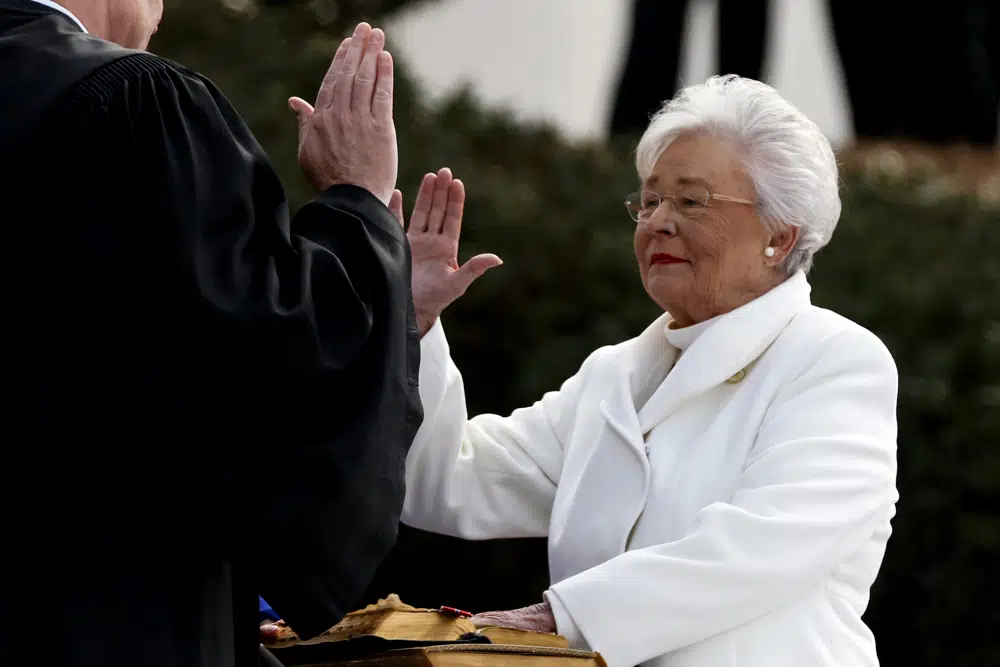
Alabama has changed death penalty procedures to give the prison system more time to carry out executions — a move that comes after a string of troubled lethal injections in the state — and also eliminated an automatic review for trial errors in death penalty cases. Alabama Gov. Kay Ivey’s office called the time window change a “win for justice,” and supporters said the appeal change would ease the burden on the court system. But a noted death penalty lawyer said the changes end a crucial avenue of review and increase the likelihood of “more cruelty and potential torture.” The Alabama Supreme Court announced the changes to appellate procedure last Friday. At Ivey’s request, the court abolished the previous one-day time frame to carry out a death sentence. Instead, the governor will set a window of time for the execution. A divided court in a 6-3 decision also eliminated an automatic “plain error review” where the Alabama Court of Criminal Appeals automatically reviews death penalty cases for a clear error at trial even though the defense lawyer did not object. Justices said judges on the appeals court may undertake the review but are no longer required to do so. “I think the combination of these two rules increases the likelihood that we’re going to see more wrongful convictions, more unjust sentences, and more cruelty and potential torture,” said Bryan Stevenson, founder of the non-profit Equal Justice Initiative. Stevenson said that nearly 40% of the reversals in Alabama death penalty cases have come under the plain error review. He said the rule has been in place since the death penalty was reinstated in Alabama in 1976, and its repeal is “shocking.” Justice Jay Mitchell wrote in a concurring opinion that the change will relieve the court’s burden, so they are no longer required to “scour the record in search of such errors, nor will it be compelled to analyze claims of error.” He said lawyers for death row inmates can present the issues in other appeals. “Plain-error review requires already overloaded appellate courts to spend hundreds, if not thousands, of hours per case scrutinizing trial-court records for possible errors and then explaining why those errors are (or are not) reversible,” Mitchell wrote. However, two justices who are former members of the Court of Criminal Appeals dissented in the decision. Justice Kelli Wise wrote that she could not support a complete repeal despite the time required. “In these cases, the defendants’ very lives are at stake, and I believe that such cases are entitled to heightened review on direct appeal,” Wise wrote. The court also granted Ivey’s request to expand the amount of time that Alabama has to carry out an execution. Ivey asked for the change after announcing a “top-to-bottom” review of execution procedures. The review came after an unprecedented third failed lethal injection in the state following problems with intravenous lines and late-running appeals. Death warrants issued by the Supreme Court had been limited to a single day, resulting in a midnight deadline to get the execution underway. Now, after the court issues a death warrant, the governor will set a time window to carry out the execution. Justices left it up to the governor to decide how long that time window will be. “I view this as a win for justice. As we initially interpret the order, it secures an extended time frame, which was a primary request of the governor’s,” Ivey spokeswoman Gina Maiola said in an email. She said the governor’s staff will review the order with the prison system. Stevenson says while other states give longer than a day, no state allows a governor that kind of power. He said it would allow already problematic executions to go on for longer. The state in November called off the execution of Kenneth Eugene Smith, which was the state’s second such instance of being unable to put an inmate to death in the preceding two months and its third since 2018. The state completed an execution in July, but only after a three-hour delay caused at least partly by the same problem with starting an IV line. Republished with the permission of The Associated Press.
Academy of Honor recognizes accomplished Alabamians

The nation’s defense secretary and a pioneering social justice activist are among new members inducted Thursday into the Alabama Academy of Honor. The Academy honors 100 living Alabamians for their accomplishments and service to the state and nation. The ceremony included honorees for 2020 because that year’s ceremony was postponed because of the COVID-19 pandemic. The 2020 honorees are: Equal Justice Initiative founder Bryan Stevenson, former U.S. Congressman Jo Bonner, retired Maj. Gen. J. Gary Cooper, a decorated Vietnam veteran and the first Black officer in the Marine Corps to lead an infantry company into combat. The 2021 honorees are U.S. Secretary of Defense Lloyd Austin, Huntsville attorney Julian Butler, retired judge John England Jr., former Lockheed Martin CEO Marillyn Hewson, Grammy-award-winning recording artist Lionel Richie, and UAB’s Senior Vice President of Medicine Dr. Selwyn Vickers. Republished with the permission of the Associated Press.
Alabama bypasses bid process to move fast on prison builds
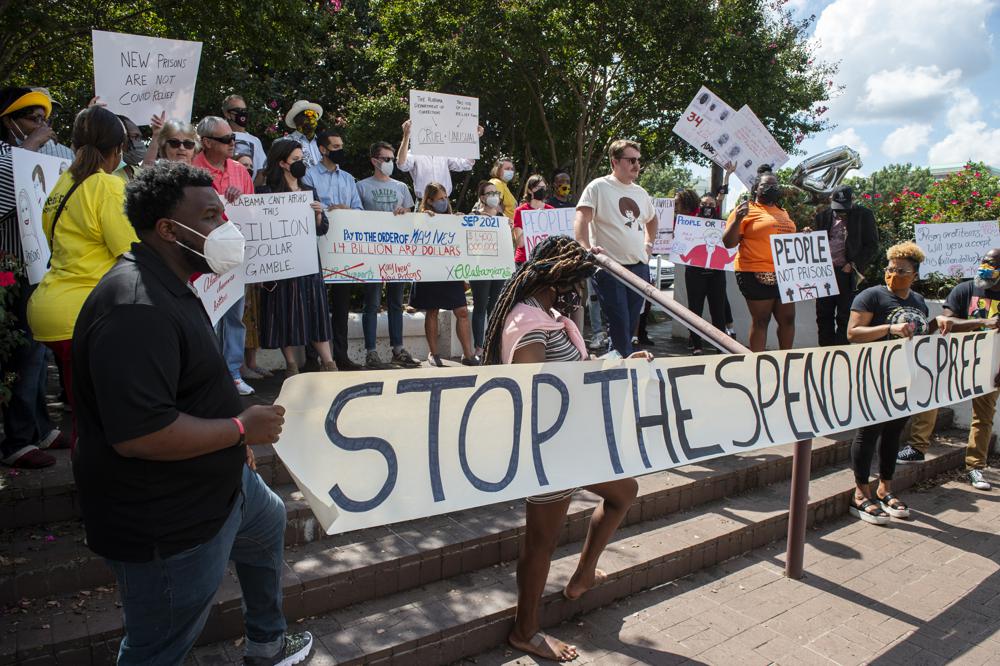
Alabama intends to move quickly on building new prisons under a plan that taps pandemic relief funds and could skip the normal bidding process for the construction of two supersize facilities. Alabama Gov. Kay Ivey Friday signed into law the $1.3 billion construction plan to build two 4,000-bed prisons and a new prison for women and renovate other facilities. The plan taps $400 million from the American Rescue Plan — money the state has already received — and could steer the construction contracts toward companies that previously qualified for the work. The construction bill signed into law bypasses the normal bidding process for the two 4,000-bed facilities. It specifies that the state instead can negotiate directly with entities that were part of development teams that qualified for the projects under a lease plan that Ivey’s administration had pursued but abandoned. Those entities include Birmingham-based construction giant BL Harbert International and Montgomery-based Caddell Construction. Caddell and BL are each expected to be the main contractors for one of the two prisons, Republican Sen. Greg Albritton said. Lawmakers said working with those companies will allow the state to incorporate the prior work, saving both time and money. “The main thing is time, and time is of the essence. This is going to enable us to start these projects 12 months in advance, and time is money,” said the bill’s sponsor, Republican Rep. Steve Clouse. House Speaker Mac McCutcheon, defending the selection language, said the companies previously went through a selection process under the lease plan. The law specifies that if the state doesn’t reach an agreement with one of those companies, officials will start over with a fresh selection process seeking bids on the work. Alabama officials will have the money to start construction after lawmakers approved $400 million in virus funds and another $150 million from the state’s general fund, in addition to agreeing to borrow $785 million through a bond issue. “We can start this construction now with the money we have on hand now … without having to wait to float bonds,” Albritton said. “I believe we’re going to see dirt flying in January.” The U.S. Department of Justice has sued Alabama over a prison system “riddled with prisoner-on-prisoner and guard-on-prisoner violence.” The Justice Department noted in an earlier report that dilapidated facilities were a contributing factor to the unconstitutional conditions but wrote “new facilities alone will not resolve” the matter because of problems in culture, management deficiencies, corruption, violence, and other problems. Dozens of advocacy groups objected to the prison construction plan. “We do not believe the issues facing Alabama’s prisons are about the buildings,” said Bryan Stevenson, executive director and founder of the Equal Justice Initiative. “We think it’s entirely about leadership, culture, and the practices,” Stevenson said. “I just think engaging in a costly effort around new prisons is not going to solve the problem and worse is distracting us from dealing with the prisons.” Republished with the permission of the Associated Press.
No jail time in 1st riot sentence; Oath Keeper pleads guilty

An Indiana woman on Wednesday became the first defendant to be sentenced in the Jan. 6 insurrection at the U.S. Capitol and avoided time behind bars, while a member of the Oath Keepers extremist group pleaded guilty in a conspiracy case and agreed to cooperate with prosecutors in a major step forward for the massive investigation. The two developments signal that the cases against those charged in the deadly siege are slowly advancing, even as the U.S. Department of Justice and the courthouse in Washington, D.C., struggle under the weight of roughly 500 federal arrests across the U.S. And it comes as Republicans in Washington attempt to downplay the violence committed by members of the mob supporting former President Donald Trump. Graydon Young, who was accused alongside 15 other members and associates of the Oath Keepers of conspiring to block the congressional certification of Joe Biden’s presidential victory, pleaded guilty to two counts: conspiracy and obstruction of an official proceeding. It was the first guilty plea in the major conspiracy case brought against members of the group. The second charge calls for up to 20 years in prison, but U.S. District Judge Amit Mehta said federal sentencing guidelines call for Young to serve between 5 1/4 years and 6 1/2 years behind bars. Prosecutors may seek even less time in exchange for his cooperation against other defendants. Young, 55, of Englewood, Florida, was arrested in February and charged in the sweeping conspiracy case accusing members of the Oath Keepers of coming to Washington prepared to use violence and intent on stopping the certification of the vote. Authorities said in court documents that Young joined the Florida chapter of the Oath Keepers in December, writing that he was “looking to get involved in helping …” Later that month, Young reached out to a company that does firearms and combat training about a rifle class for four people, according to the indictment. Authorities say, Young, wearing a helmet and tactical vest, was part of the military-style “stack” seen on camera marching through the crowd before entering the Capitol building. Young’s attorneys didn’t immediately respond to emails sent Wednesday seeking comment. Another Oath Keepers member, Jon Ryan Schaffer, has also pleaded guilty in the riot but was not charged in the conspiracy case. Schaffer has agreed to cooperate with investigators and potentially testify against other defendants. Anna Morgan Lloyd, 49, of Indiana, was ordered by a federal judge to serve three years of probation, perform 120 hours of community service and pay $500 in restitution after admitting to unlawfully entering the Capitol. She pleaded guilty to a single misdemeanor charge under a deal with prosecutors. After the riot, Lloyd described Jan. 6 on Facebook as the “best day ever.” On Wednesday, she apologized to the court, her family, and “the American people,” saying she went to Washington that day to peacefully show her support for Trump. “I’m ashamed that it became a savage display of violence that day. And I would have never been there if I had a clue it was going to turn out that way,” Lloyd told the judge. “It was never my intent to be a part of anything that’s so disgraceful to our American people.” In seeking probation for Lloyd, prosecutors noted that she was not involved in any violence and destruction or preplanning and coordination of the Capitol breach. Lloyd was invited by her hairdresser to drive to Washington to hear Trump speak, her attorney wrote in court documents. U.S. District Court Judge Royce Lamberth said he was giving her a “break” but didn’t want others to think that probation — and not a stiffer sentence — would be the norm. “Legally, I could give you the six months, but is that really what we want our judiciary to do?” the judge asked. Lamberth said he struggled with what would be an appropriate sentence for Lloyd because he views the riot as a serious crime. “This wasn’t a peaceful demonstration the way it turned out. It was not an accident,” he said. “It was intended to and brought a halt to the very functioning of our government.” He said he was “especially troubled” by some lawmakers who are seeking to rewrite the history of the Capitol riot. “I don’t know what planet they were on, but there were millions of people in this country that saw what happened on Jan. 6 and that saw what you saw and what you just described: a disgrace to our country,” the judge said. In a letter to the judge asking for leniency, Lloyd wrote that she was a registered Democrat but that she and her husband began supporting Trump in 2016 because “he was standing up for what we believe in.” After her arrest, Lloyd’s lawyer gave her a list of books and movies to help her “see what life is like for others in our country,” Lloyd wrote. Lloyd said she has sought to educate herself by watching movies such as “Schindler’s List” and the History Channel’s “Burning Tulsa” and reading Bryan Stevenson’s “Just Mercy.” “I’ve lived a sheltered life and truly haven’t experienced life the way many have,” Lloyd wrote. “I’ve learned that even though we live in a wonderful country things still need to improve. People of all colors should feel as safe as I do to walk down the street.” Four other people — a Tennessee man, a Maryland man, and a Virginia couple — have pleaded guilty to the same misdemeanor charge in the last two weeks. Earlier Wednesday, another man, Robert Maurice Reeder of Maryland, admitted to entering the Capitol, but his lawyer said he didn’t force his way inside and didn’t damage any property or hurt anyone. Before his arrest, an attorney for Reeder provided federal authorities with a compilation of photos and videos that he took with his cellphone at the Capitol. A video seemed to show Reeder chanting, “Fight for Trump!” and he recorded an assault on a Capitol police officer, according to the FBI. “You
Alabama lawyer depicted in ‘Just Mercy’ wins ‘alternative Nobel’
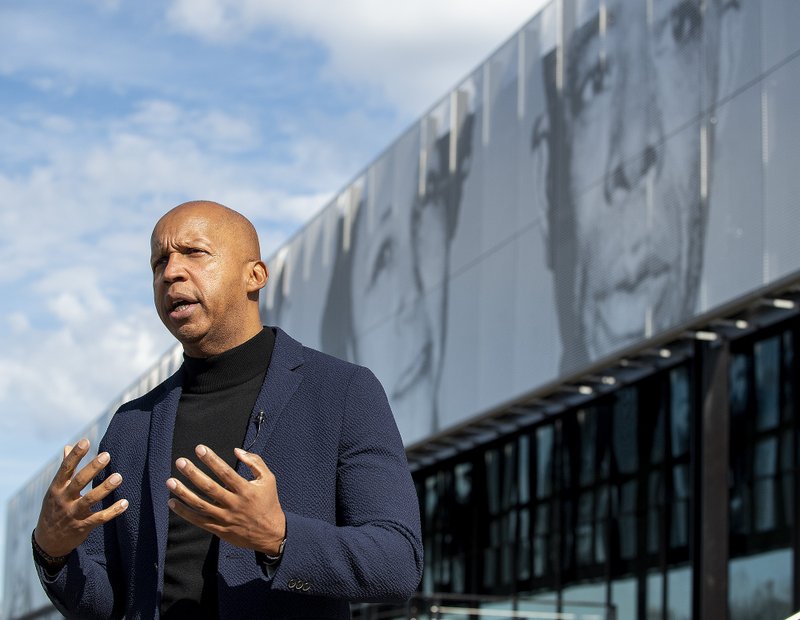
Bryan Stevenson, who founded the Equal Justice Initiative in 1989, was named a recipient of annual Right Livelihood Award.
Time.Com names Bryan Stevenson as one of the 31 people changing the south

Only one Alabamian made Time.com’s list of the 31 people who are “changing the south.” And while you might not know his name, you definitely know his work. Bryan Stevenson, the founder and executive director of the Equal Justice Initiative (EJI) in Montgomery, Ala. is a public interest attorney who has dedicated his career to helping “the poor, the incarcerated and the condemned,” according to the Equal Justice Initiative. Since the 1980’s, when Stevenson founded EJI, the group has won several major legal challenges including: eliminating excessive and unfair sentencing, exonerating innocent death row prisoners, confronting abuse of the incarcerated and the mentally ill and aiding children prosecuted as adults. Stevenson and his staff are responsible for reversing, releasing, and relieving over 125 wrongly convicted prisoners on death row, and successfully won a historic ruling in the supreme court in 2012 – stating that mandatory life-without-parole sentences for all children 17 or younger are unconstitutional. On top of his already impressive legal career, Stevenson is a professor at the New York University School of Law, has received 29 honorary doctoral degrees including degrees from Harvard, Yale, Princeton, and Oxford University, and is a New York Times bestseller’s list author for his book Just Mercy. But none of these things are listed as the reason Time.com chose to honor him. “He came to the South to advocate for prisoners facing execution, almost all of whom were black,” TIME reported. “Legal executions of African Americans had surged, but not out of the blue; they climbed just when lynchings were deemed unseemly. What had taken place on the courthouse lawn moved indoors, black robes replacing white.” “If you’re in a country where we have just refused to acknowledge the history of slavery, I think that creates a certain kind of comfort with that history—a certain indifference to the victimization and the anguish and the trauma that that history created, which we can only address by talking more directly about that history,” Stevenson told TIME. “I am a proponent of truth and reconciliation. I just think those things are sequential.” With that in mind, Stevenson began a new project in Montgomery: the National Memorial for Peace and Justice, the first memorial in the nation devoted solely to victims of lynching. Over 10,000 people visited the memorial and museum within the first week of its opening in April, and tourism officials estimate they could attract 100,000 more visitors in the next year. “One young man, Dimitri Digbeu Jr., who drove 13 hours from Baltimore to see the memorial, said he thought it had singlehandedly ‘rebranded’ Montgomery,” the Associated Press reported “There is still so much to be done in this country to recover from our history of racial inequality,” Stevenson told the Associated Press. “I’m hopeful that sites like the ones we’re building and conversations like the ones we’re organizing will empower and inspire people to have the courage to create a more just and healthy future. We can achieve more in America when we commit to truth-telling about our past.” “We are not just slave states in the American South. We are not just lynching states. We are not just segregation states. We are more than that. The people are more than that. The region is more than that,” Stevenson told TIME. “But we can’t ignore this part of our history that we have been so reluctant to address if we want to be seen as we truly are.”
Lynching memorial and museum in Alabama draw crowds, tears
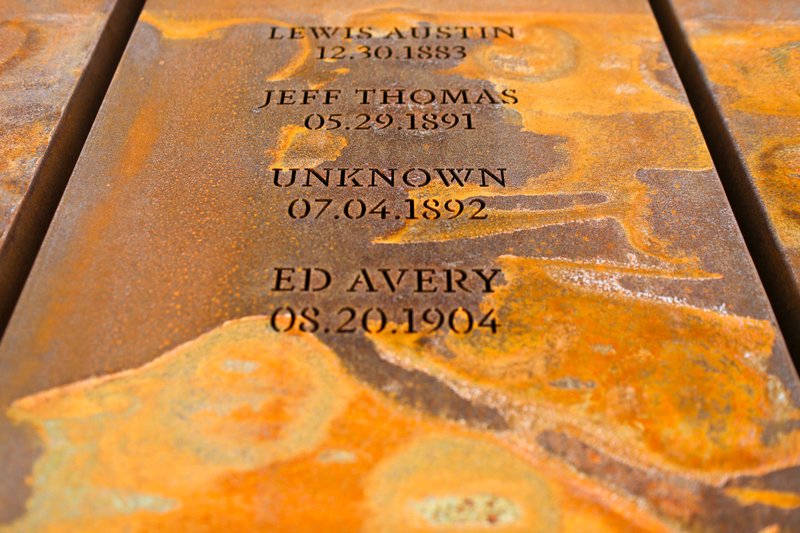
Tears and expressions of grief met the opening of the nation’s first memorial to the victims of lynching Thursday in Alabama. Hundreds lined up in the rain to get a first look at the memorial and museum in Montgomery. The National Memorial for Peace and Justice commemorates 4,400 black people who were slain in lynchings and other racial killings between 1877 and 1950. Their names, where known, are engraved on 800 dark, rectangular steel columns, one for each U.S. county where lynchings occurred. A related museum, called The Legacy Museum: From Enslavement to Mass Incarceration, is opening in Montgomery. Many visitors shed tears and stared intently at the commemorative columns, many of which are suspended in the air from above. Toni Battle drove from San Francisco to attend. “I’m a descendant of three lynching victims,” Battle said, her face wet with tears. “I wanted to come and honor them and also those in my family that couldn’t be here.” Ava DuVernay, the Oscar-nominated film director, told several thousand people at a conference marking the memorial launch to “to be evangelists and say what you saw and what you experienced here. … Every American who believes in justice and dignity must come here … Don’t just leave feeling like, ‘That was amazing. I cried.’ … Go out and tell what you saw.” As for her own reaction, DuVernay said: “This place has scratched a scab. It’s really open for me right now.” Angel Smith Dixon, who is biracial, came from Lawrenceville, Georgia, to see the memorial. “We’re publicly grieving this atrocity for the first time as a nation. … You can’t grieve something you can’t see, something you don’t acknowledge. Part of the healing process, the first step is to acknowledge it.” The Rev. Jesse Jackson, a longtime civil rights activist, told reporters after visiting the memorial that it would help to dispel America’s silence on lynching. “Whites wouldn’t talk about it because of shame. Blacks wouldn’t talk about it because of fear,” he said. The crowd included white and black visitors. Mary Ann Braubach, who is white, came from Los Angeles to attend. “As an American, I feel this is a past we have to confront,” she said as she choked back tears. DuVernay, Jackson, playwright Anna Deavere Smith, the singing group Sweet Honey in the Rock, Congressman John Lewis and other activists and artists spoke and performed at an opening ceremony Thursday night that was by turns somber and celebratory. Among those introduced and cheered with standing ovations were activists from the 1950s Montgomery bus boycott, Freedom Rider Bernard Lafayette, and one of the original Little Rock Nine, Elizabeth Eckford. “There are forces in America today trying to take us back,” Lewis said, adding, “We’re not going back. We’re going forward with this museum.” Singer Patti Labelle ended the evening with a soulful rendition of “A Change is Gonna Come.” Other launch events include a “Peace and Justice Summit” featuring celebrities and activists like Marian Wright Edelman and Gloria Steinem in addition to DuVernay. The summit, museum and memorial are projects of the Equal Justice Initiative, a Montgomery-based legal advocacy group founded by attorney Bryan Stevenson. Stevenson won a MacArthur “genius” award for his human rights work. The group bills the project as “the nation’s first memorial dedicated to the legacy of enslaved black people, people terrorized by lynching, African-Americans humiliated by racial segregation and Jim Crow, and people of color burdened with contemporary presumptions of guilt and police violence.” Several thousand people gave Stevenson a two-minute standing ovation at a morning session of the Peace and Justice Summit. Later in the day, Edelman, founder of the Children’s Defense Fund, urged the audience to continue their activism beyond the day’s events on issues like ending child poverty and gun violence: “Don’t come here and celebrate the museum … when we’re letting things happen on an even greater scale.” Republished with the permission of the Associated Press.
What’s inside Montgomery’s new national peace memorial and slavery legacy museum
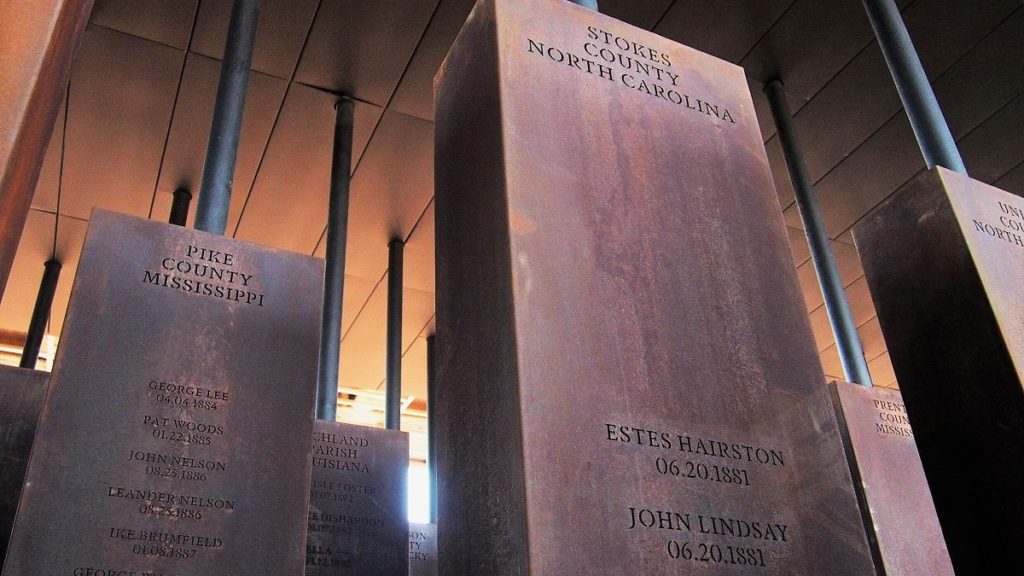
The Equal Justice Initiative (EJI) will open two institutions Thursday as part of its work to advance truth and reconciliation around race in America and to confront the legacy of slavery, lynching and segregation. The openings of the National Memorial for Peace and Justice and the Legacy Museum: From Enslavement to Mass Incarceration will be accompanied by several days of panel discussions and presentations from national civil rights figures. There will also be performances and concerts featuring acclaimed artists and an opening ceremony. The Montgomery-based EJI litigates on behalf of prisoners who may have been wrongly convicted of crimes, were without effective legal counsel or who may have been denied a fair trial, as well as juveniles prosecuted as adults. The memorial and museum are designed to promote the just treatment of all people. “There is still so much to be done in this country to recover from our history of racial inequality,” said EJI Founder and Executive Director Bryan Stevenson. “I’m hopeful that sites like the ones we’re building and conversations like the ones we’re organizing will empower and inspire people to have the courage to create a more just and healthy future. We can achieve more in America when we commit to truth-telling about our past.” Here are closer looks at the memorial and the museum. The National Memorial for Peace and Justice This is the nation’s first memorial dedicated to the legacy of enslaved black people, people terrorized by lynching, African-Americans humiliated by racial segregation and Jim Crow, and people of color burdened with contemporary presumptions of guilt and police violence. Work on the memorial began in 2010, when EJI staff began investigating thousands of lynchings in the South, many of which had never been documented. Six million black people fled the South as refugees and exiles as a result of lynchings, and the EJI was interested in understanding not only lynching but the terror and trauma it created in the black community. This interest led to the 2015 EJI report Lynching in America: Confronting the Legacy of Racial Terror, which documented thousands of lynchings in 12 states. Since its initial release, the original research has been supplemented with data related to lynchings in states beyond the Deep South. EJI staffers visited hundreds of lynching sites, collected soil and erected public markers in an effort to reshape the cultural landscape with monuments and memorials that accurately reflect history. For the National Memorial for Peace and Justice, the EJI partnered with artists like Ghanaian native Kwame Akoto-Bamfo, whose sculpture on slavery confronts visitors when they enter the memorial. From there, text, narrations and monuments to lynching victims take visitors on a journey from slavery through lynching and racial terror. In the center of the site, visitors encounter a memorial square, created with assistance from the MASS Design Group. The memorial experience continues through the civil rights era, brought to life through a Dana King sculpture dedicated to the women who sustained the Montgomery Bus Boycott. Finally, the memorial journey ends with contemporary issues of police violence and racially biased criminal justice expressed in a work by artist Hank Willis Thomas. Displayed throughout the memorial are writings from Toni Morrison and words from the Rev. Martin Luther King Jr., and there is a reflection space in honor of pioneering African-American journalist Ida B. Wells. One of the most poignant features is the memorial square, featuring 800 six-foot monuments that symbolize the thousands of racial terror lynching victims in the U.S. and the counties and states where this terrorism took place. Legacy Museum: From Enslavement to Mass Incarceration The 11,000-square-foot museum, built on the site of a former warehouse that imprisoned enslaved black people, is midway between a historic slave market and the main river dock and train station where tens of thousands of enslaved people were trafficked during the height of the domestic slave trade. By 1860, Montgomery was the capital of the domestic slave trade in Alabama, one of the two largest slave-owning states in America. The Legacy Museum employs technology to dramatize the enslavement of African-Americans, as well as the evolution of racial terror lynchings, legalized racial segregation and racial hierarchy in America. Relying on rarely seen first-person accounts of the domestic slave trade, the EJI’s research materials, videography, exhibits on lynching and recently composed content on segregation, the museum explores the history of racial inequality and its relationship to a range of contemporary issues, including mass incarceration and police violence. “Our nation’s history of racial injustice casts a shadow across the American landscape,” Stevenson said. “This shadow cannot be lifted until we shine the light of truth on the destructive violence that shaped our nation, traumatized people of color and compromised our commitment to the rule of law and to equal justice.” Museum visitors encounter slave-pen replicas, where they can see, hear and get close to what it was like to be imprisoned while awaiting sale at the nearby auction block. First-person accounts from enslaved people narrate the sights and sounds of the domestic slave trade. Extensive research and videography vividly expose the racial terrorism of lynching and the humiliation of the Jim Crow South. And compelling data-rich exhibits about America’s history of racial injustice and its legacy give visitors the opportunity to investigate the dynamic connections across generations of Americans affected by the narrative of racial difference. The Legacy Museum houses the nation’s most comprehensive collection of data on lynching. It also presents previously unseen archival information about the domestic slave trade brought to life through new technology. As a physical site and an outreach program, the facility is an engine for education about the legacy of racial inequality. To read more about EJI, click here. Republished with the permission of Alabama Newscenter.


